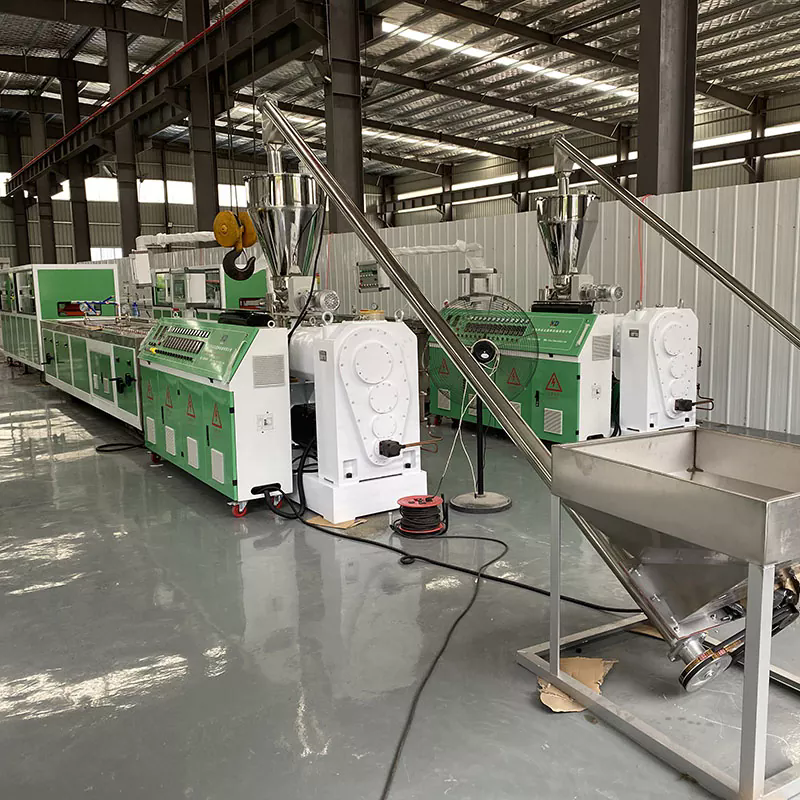Plastic Profile Equipment: Revolutionizing Manufacturing Processes
2025-05-19
In the modern manufacturing industry, plastic profile equipment has become an essential tool for producing a wide variety of plastic profiles used in numerous applications. From construction and automotive to home appliances and packaging, plastic profiles are integral to many industries. The machinery used to create these profiles is specialized, offering precision, efficiency, and versatility. In this article, we will explore the role of plastic profile equipment, its types, benefits, and the impact it has on production lines.

What is Plastic Profile Equipment?
Plastic profile equipment refers to the machinery used in the production of various plastic profiles, such as window frames, pipes, trims, and seals. These profiles are produced through extrusion, a process where plastic material is heated and forced through a mold or die to shape it into a specific profile or design.
The equipment involved in plastic profile manufacturing is highly specialized and designed to provide high precision, speed, and quality. It includes extruders, dies, cooling systems, cutting machines, and other auxiliary devices that work in harmony to create finished plastic profiles with the required specifications.
Key Components of Plastic Profile Equipment
1. Extruder: The heart of the plastic profile equipment, the extruder melts plastic pellets or resin and forces them through a die to create the desired shape. The extruder ensures consistent material flow and temperature control, which is critical for producing high-quality profiles.
2. Die: The die is a crucial component that determines the shape and size of the plastic profile. It is designed to match the desired specifications, whether it's for a simple pipe or a complex window frame. Dies can be custom-made to meet the specific needs of a product.
3. Cooling System: After the plastic has been shaped by the die, it must cool down to solidify. The cooling system ensures that the profile maintains its shape and dimensions. Typically, water or air cooling is used, depending on the type of plastic and the specific application.
4. Puller: A puller is used to guide the plastic profile through the production line after it exits the die. It ensures the material moves at a consistent speed and prevents any deformation or warping of the profile during the cooling process.
5. Cutting Machine: Once the plastic profile has been cooled and solidified, it is cut into specified lengths using a cutting machine. This machine ensures that each piece meets the required size and is free from defects.
6. Auxiliary Equipment: In addition to the main components, plastic profile production lines often include additional equipment such as material feeders, conveyors, and quality control systems to monitor the production process and maintain high standards.
Types of Plastic Profile Equipment
1. Single-Screw Extruder: This is the most commonly used type of extruder for plastic profile production. It consists of a single rotating screw inside a barrel, which pushes the plastic material through the die. Single-screw extruders are known for their simplicity and versatility.
2. Twin-Screw Extruder: Twin-screw extruders are used for more complex applications where the mixing of different types of plastic or additives is required. The two screws rotate in either the same or opposite directions, allowing for better blending and homogenization of materials.
3. Vacuum Calibration System: This system is often used in combination with extrusion to maintain the shape and size of the profile. The vacuum calibration system ensures that the profile cools down while being held in place, preventing any deformation during the solidification process.
4. Co-Extrusion System: In some cases, different types of plastic are combined to form a multilayer profile. The co-extrusion system enables the simultaneous extrusion of multiple plastic materials, allowing for the creation of profiles with different functional layers, such as UV resistance or color variations.
5. Vertical or Horizontal Cooling Tanks: Depending on the type of profile and production needs, plastic profile equipment may include either vertical or horizontal cooling tanks. These tanks provide the necessary environment for the profile to solidify without any defects.
Benefits of Plastic Profile Equipment
1. Precision and Quality: One of the primary benefits of using plastic profile equipment is the ability to produce high-quality, precise products. The machinery is designed to meet tight tolerances and produce profiles with uniform thickness and consistent dimensions.
2. High Production Capacity: Modern plastic profile equipment is capable of high-speed production, which is essential for meeting the demands of industries that require large quantities of plastic profiles. The efficiency of the equipment ensures fast turnaround times and increased productivity.
3. Versatility in Material Choices: Plastic profile equipment can process a variety of plastic materials, including PVC, polyethylene, polypropylene, and more. This versatility allows manufacturers to choose the most suitable material for each application, whether it requires strength, flexibility, UV resistance, or aesthetic appeal.
4. Customization: Plastic profile equipment can be tailored to produce a wide range of profile shapes, sizes, and designs. This flexibility makes it ideal for creating custom products that meet specific customer requirements.
5. Reduced Waste: The precision and efficiency of modern plastic profile equipment result in minimal material waste. This not only reduces production costs but also makes the process more environmentally friendly by lowering material consumption.
6. Energy Efficiency: With advancements in technology, modern plastic profile equipment is designed to be more energy-efficient. Features like improved heating systems, cooling mechanisms, and optimized extrusion processes help to reduce overall energy consumption during production.
Applications of Plastic Profile Equipment
Plastic profile equipment is used in a variety of industries and applications, including:
1. Construction: Plastic profiles, such as window frames, door seals, and insulation materials, are essential in the construction industry. Plastic profile equipment allows for the production of weather-resistant, durable, and customizable building components.
2. Automotive: In the automotive industry, plastic profiles are used in dashboards, trim panels, seals, and weatherstripping. The ability to create precise and reliable parts is crucial for vehicle performance and aesthetics.
3. Packaging: Plastic profile equipment is widely used to produce packaging materials such as trays, boxes, and containers. The ability to create lightweight yet strong profiles makes plastic an ideal choice for packaging solutions.
4. Electronics: Plastic profiles are used in the production of electrical enclosures, wiring channels, and other components in the electronics industry. The profiles provide protection for sensitive electronic devices and cables.
5. Consumer Goods: Items like plastic trims, furniture parts, and accessories are often made using plastic profile equipment. The ability to customize shapes and sizes ensures that products meet consumer expectations.
Conclusion
Plastic profile equipment has revolutionized the way manufacturers produce plastic profiles, offering precision, versatility, and efficiency. With its wide range of applications in industries such as construction, automotive, electronics, and packaging, plastic profile equipment plays a critical role in creating high-quality products that meet the needs of modern consumers. As technology continues to advance, these machines will only become more efficient, sustainable, and capable of producing even more complex and customized plastic profiles.


